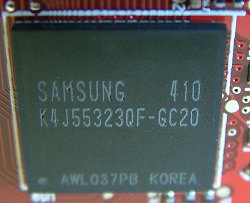Card appearance
Before we begin our appraisal of Crucial's card, it's worth remembering (or learning) what makes ATI's new R420-based GPUs tick. Ryszard took a look at the new technologies inherent in the Platinum Edition, and by inference to the PRO model, here. In brief summary, the PRO, it transpires, uses a 12-pipeline rendering setup with a 475MHz core, a 256-bit memory bus that's stated to run off 900MHz-rated GDDR3 memory, and nifty new tech. such as temporal antialiasing. The XT PE may be the current jewel in ATI's crown, but the PRO is still a damn fast card in its own right. Crucially (no pun intended), retail models are positioned in the sub-£300 category.
Take a look at a reference ATI Radeon X800 XT Platinum Edition, here, and play a game of spot the difference. There isn't a whole lot in it. Unlike, for example ASUS, Crucial is content by adding a small branded sticker to R420's cooler. Everything else, really, is strictly reference. That translates to a clean-looking card that uses a deceptively small PCB board. In fact, it's quite difficult to tell a reference 9800 XT, X800 PRO and X800 X PE apart.

Looking at it from the front viewpoint, we can see ATI's ribbed copper cooler sitting just above the double-sided GDDR3 RAM modules. As with previous iterations of ATI's GPUs, this one uses a shim to protect the graphics core. The heavy copper cooler isn't just for aesthetic purposes; it's a proven design that's both efficient and quiet. Also, unlike NVIDIA's most beastly cards, both X800 PRO and XT PE use a single Molex connector for additional power.

X800 XT PEs and PROs can be technologically differentiated on at least two counts. The PRO variants ship with a 12-pipe rendering setup, 4 less than the PE's 16. Also, PROs tend to be clocked in at 475MHz core and 900MHz memory, compared with the PE's 520MHz core and 1120MHz memory. Both, however, use GDDR3 memory that's usually supplied by Samsung. Crucial's card has 256MB of 1000MHz-rated GDDR3. The GPU cooler's design makes it difficult for Crucial to add in RAMsinks, but with the RAM already over 100MHz above card specifications it's not really an issue.

Crucial's stuck with what tried and tested. Connectivity-wise, that means VGA, S-Video, and a single DVI-I interface. I'd like to see a dual-DVI-equipped X800 PRO. Sadly, it doesn't seem as if it will come from the Crucial stable of cards.

Crucial keeps up the reference them by opting to do without the cheap Rage Video-In Video-Out (VIVO) ASIC that some partners swear by. It boils down to what you want from a top-end graphics card. Is it pure gaming performance at a price, or a feature-laden card that's often significantly more expensive. Crucial, it seems, reckons X800 PROs should be pure gaming cards.









